This piece also runs on Streetsblog Chicago editor-at-large Steven Vance's real estate development website Chicago Cityscape.
The Connected Communities ordinance — adopted last year — required that the Chicago Department of Transportation establish Transportation Demand Management rules for new construction developments in the overlap of B, C, and D zoning districts, and a half mile around CTA and Metra rail stations.
TDM is the name of policies and strategies that collectively aim to influence personal transportation choices and reduce the prevalence of traffic-causing single-occupancy vehicle trips (people traveling alone in their own cars, but also ride-hail trips). This is largely done by marketing other options, increasing their attractiveness, incentivizing bundling trips, or reducing transportation costs. In some cases it could mean eliminating free parking as an employee or customer benefit and, in the case of employees, passing the savings on in the form of a cash bonus (parking cash out).
CDOT published TDM guidelines, effectively immediately, on Friday.
Rather than re-summarize what CDOT has published I’ll link to their resources & guidelines in the order I recommend reading them.
- Frequently Asked Questions. Essential reading for property owners, architects, developers, and zoning attorneys who haven’t heard of TDM.
- Developments that the guidelines apply to. Fundamentally, “the guidelines only apply to new construction within B, C, and D zoning districts within 1/2 mile of CTA and Metra stations.”Look up your property on Chicago Cityscape to determine how far away from a CTA or Metra rail station it is. Specifically, this document indicates the level of compliance each development must achieve based on its bulk and land use.
- List of possible TDM strategies to propose. The non-exhaustive list of TDM strategies describes some of the physical or programmatic changes a developer can propose to or in their development to reduce the prevalence of people driving alone to the site.
Additional strategies include on-site childcare so that caregivers can make fewer trips in a day, regardless of their transportation mode; providing a pool of e-bikes for tenants or residents to use to get groceries; building higher-quality bike rooms for tenants and workers that are more secure, closer to the street, and/or have e-bike charging points.
If you have questions about the process, email CDOT’s plan review committee. To talk to a consultant, contact MAP Strategies or Chicago Cityscape.
Worth noting: One major way to reduce single-occupancy vehicle trips is not having on-site parking, which the Connected Communities ordinance did not address for non-residential uses, allowing them to still have an unlimited amount of on-site car parking outside of the D zoning districts.

Did you appreciate this post? Please consider making a tax-deductible donation.





